Stellar Price Analysis - Continued airdrops and declining active addresses
Stellar (XLM) is a payment protocol that aims to connect banks, payment systems, and people. The XLM spot price is down 93% from the all-time high of US$0.72, set in January 2018. The market cap currently stands at US$1.15 billion, which ranks it 12th on the BraveNewCoin market cap table, with US$51 million in exchange-traded volume over the past 24 hours.
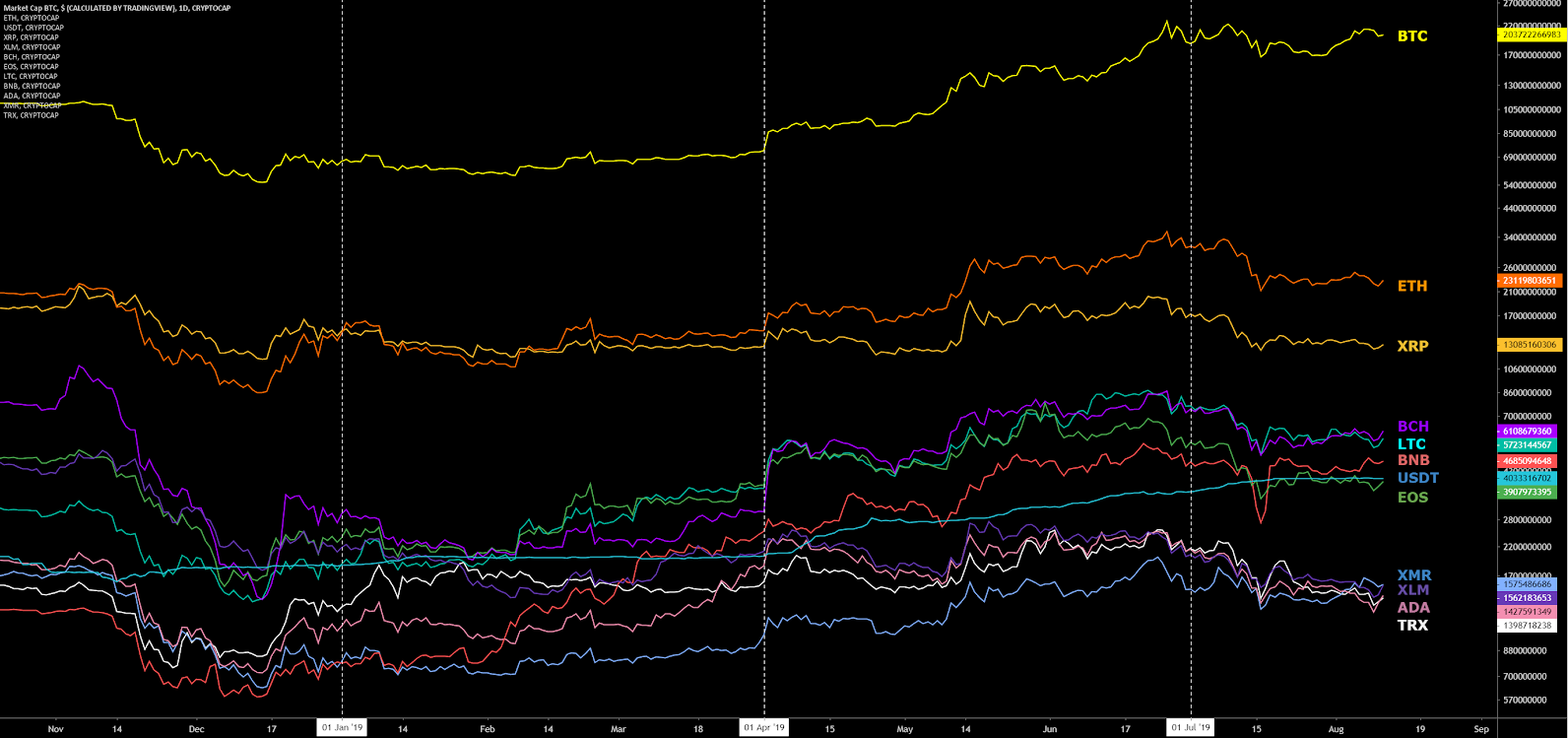
Stellar and the Stellar Development Foundation (SDF) were created by Jed McCaleb and Joyce Kim in 2014. The project is analogous to Ripple (XRP) in many ways, where McCaleb previously worked. The SDF was created to promote global financial access, literacy, and inclusion by expanding worldwide access to low-cost financial services, through the development and maintenance of technology and partnerships.
The SDF is currently run by McCaleb and Stellar’s chief scientist, David Mazières, having been incorporated in 2014 as a non-stock nonprofit corporation in the U.S. State of Delaware. The SDF is not currently an independently operated 501(c)(3), or non-profit, but did apply for this distinction in 2015.
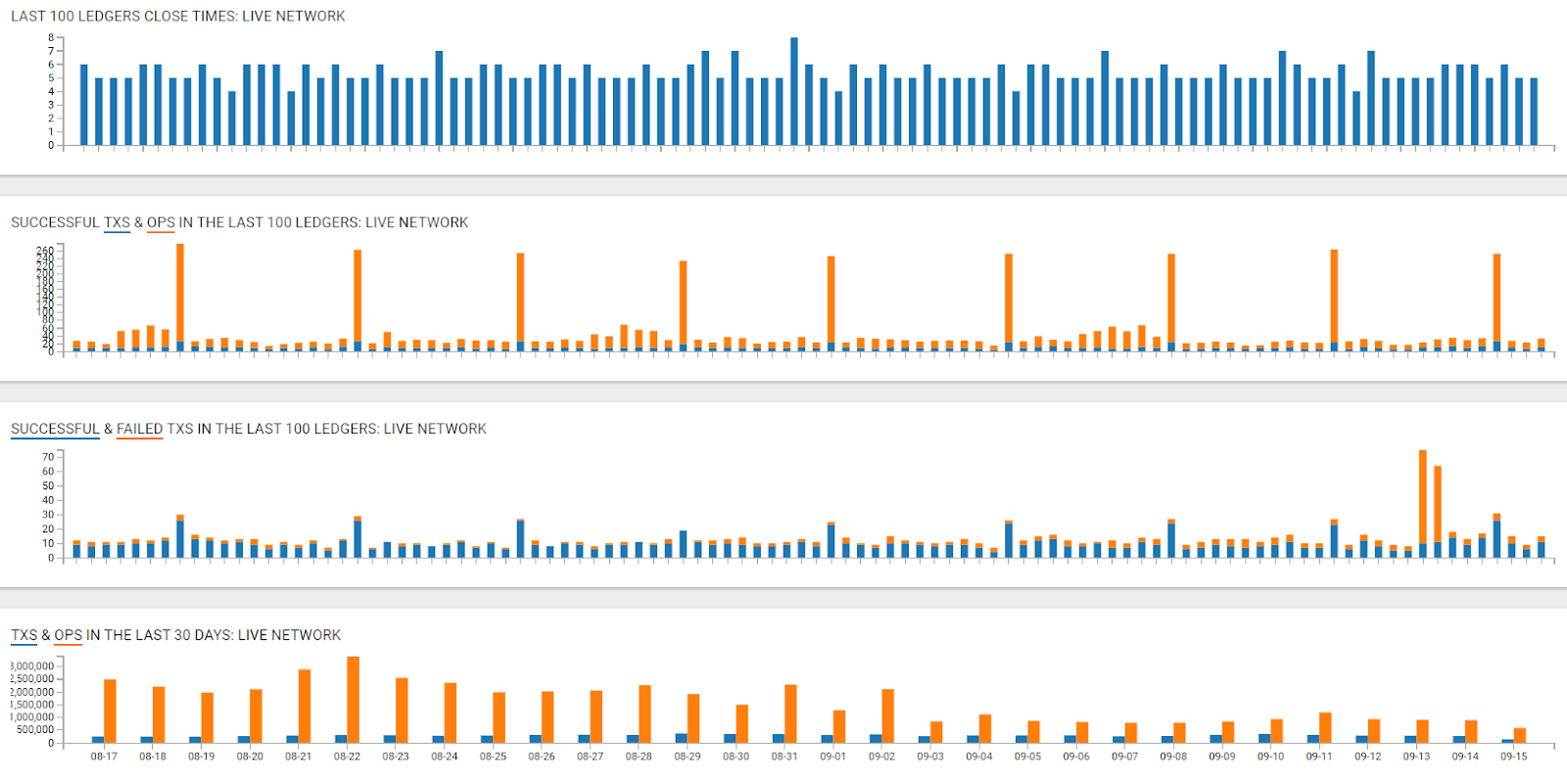
XLM originally used the Federated Byzantine Agreement (FBA) for consensus, which was pioneered by XRP. Mazières later changed XLM to use the Stellar Consensus Protocol (SCP), in 2016, after the chain was unable to maintain reliable consensus.
Neither XRP nor XLM uses Proof of Work or Proof of Stake, but instead use validators to confirm transactions on the network. Validators do not receive a block reward. Anyone in the XLM network can be a validator, so the user must decide which validators to trust. Ideally, each trust group, or quorum slice, has overlapping transactions with other groups, and thus can collectively achieve consensus.
SCP quorum intersections ensure that each quorum slice is always linked by one node with consensus agreement, based on a large pool of individuals or validators. There have been 123 public nodes and 67 validators active on the network over the past two days, with most of these nodes residing in the United States and Germany.
In April, a team of South Korean researchers released an analysis of the SCP consensus algorithm and nodes on the XLM network. Their findings revealed that all of the XLM nodes are unable to run SCP if only two nodes fail, leading to a security risk. These critical nodes are controlled by the SDF. A response from Mazières confirmed that the centralization of validators is currently a weakness in the XLM ecosystem. “Downtime does happen, so what if a set of important nodes goes down and the network halts?,” Mazières questions.
On May 15th, the XLM network stalled for 67 minutes due to an inability to reach consensus. As opposed to most other chains, which can temporarily fork when consensus is not reached, the XLM network halts completely. The SDF nodes were not the reason for the network failure. The reason for the halt was revealed in a Stellar developers blog post, “Stellar has added many new nodes recently. In retrospect, some new nodes took on too much consensus responsibility too soon.”
The XLM genesis block minted 100 billion tokens, and the supply grows at a fixed rate of 1% per year. The coins created to satisfy the yearly inflation rate are distributed through an inflation pool. The network transaction fees are also collected and placed in the inflation pool. Every account in the inflation pool votes for another account to receive the reward, which is deposited once a week. To receive rewards from the inflation pool, an account is required to obtain at least 0.05% of the total votes. Voting is weighted according to the number of lumens the voting account holds, essentially acting as a staking reward.
According to the Stellar Dashboard, there are currently 105.32 billion XLM in existence. About 8.77 billion XLM have been distributed through airdrops or to promote partnerships and user growth. Of the current total supply, 20.08 billion XLM tokens are not held by the SDF. Based on available inflation pool statistics, 5% of the total XLM circulating supply is currently being staked.
Unlike XRP, there have been no announcements of programmed or controlled escrow plans regarding the large non-circulating supply held by the SDF. There has been some concern that the holdings of the SDF are being used to perpetually collect the inflation pool reward.
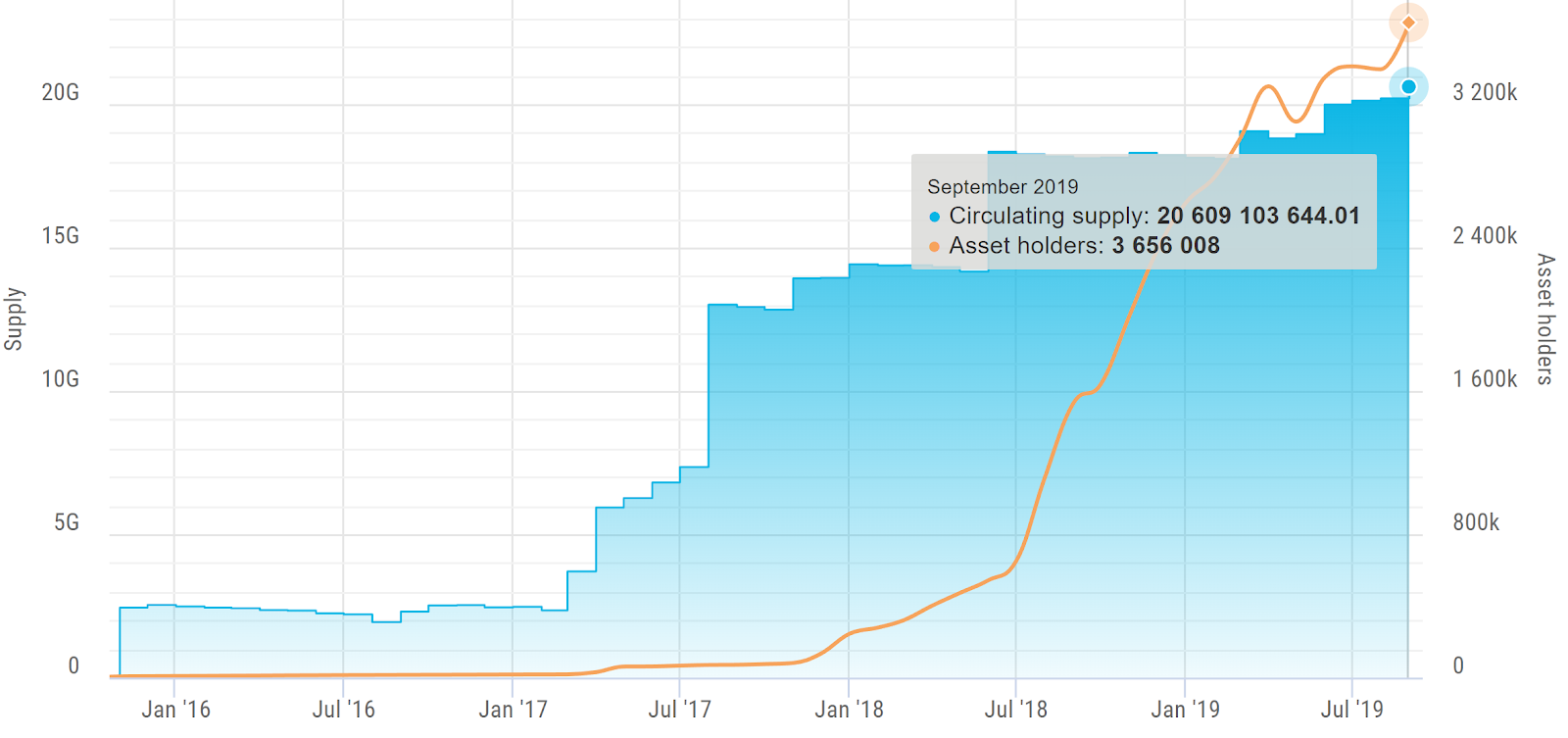
In late 2018, the SDF announced an up-to-500 million XLM distribution, or airdrop, through Blockchain.com, which added wallet support for XLM. The airdrop is ongoing and is touted as encouraging first-time crypto users, and the crypto-curious. Each user can receive US$25 in XLM, after KYC verification in the form of an email address and identity documentation. Thus far, XLM has been airdropped to 140 countries worldwide.
In March 2019, the Stellar SDF partnered with Coinbase to giveaway a further one billion XLM, through a learning exercise and referrals. Last week, the Stellar SDF also announced a two billion Lumen airdrop to Keybase users.
The Stellar team has also announced partnerships with remittance agencies Tempo and ZED, ICOs Smartlands and Mobius, at least 10 stable coins, including Stronghold and Novatti, and Hyperledger. Smartlands is a platform for security token offerings. Mobius raised US$39 million in January 2018 and compares itself to the Stripe payment gateway. Stronghold is an FDIC-insured USD stablecoin backed by IBM. Novatti is a 1:1 backed Australian dollar (AUD) stable coin, which is similar to Tether as the funds are held in a trust. Hyperledger is an open source collaborative effort created to advance cross-industry blockchain technologies and includes almost 300 companies.
Stellar has also partnered with Wirex, a fiat (GBP, USD, and EUR) and crypto Visa card processor. Users can also earn 0.5% back in BTC after each use of the Wirex Visa card. The partnership allows users to buy, store, exchange, and spend XLM on the Wirex platform. The company also plans to launch 26 stablecoins pegged to fiat currencies. On June 24th, the Wirex token (WXT) pre-sale sold out in two seconds, raising US$3 million, on OKEx’s Jumpstart IEO platform.
Earlier this year, IBM announced the launch of World Wire, which is a payment system built on the XLM network. Six international banks have signed letters of intent, indicating that they will either use XLM or issue stable coins on IBM’s service, pending regulatory review. IBM also has several validators on the XLM chain.
The XLM ecosystem also includes Interstellar, which allows enterprises and institutions to use and build on the XLM network. Interstellar combines the Chain and Lightyear brands. Chain’s products included Sequence and Chain Core. Sequence was a cloud-based ledger service for managing balances in financial and commerce applications like wallet apps, lending platforms, marketplaces, and exchanges. The Chain Core software was designed to operate and participate in permissioned blockchain networks.
The XLM network uses a default transaction fee of 0.00001 lumens to prevent spam or Denial of Service attacks. In USD terms, average transaction fees on XLM rose substantially from February to May but have since returned to the previous range (orange line, chart below). Average transaction fees on the XLM chain are much lower than most other chains, including XRP (black line, chart below).
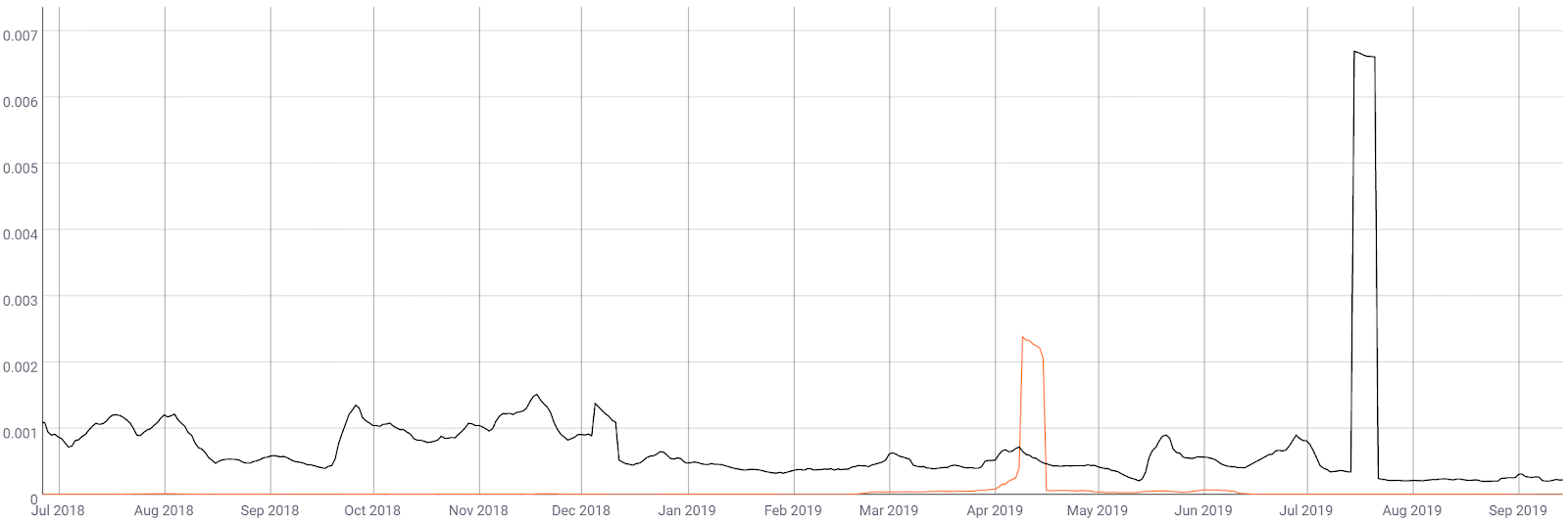
The current number of transactions per day on the network (line, chart below) stands at 230,000, and has essentially ranged between 100,000 to 300,000 since April 2018. The record high in transactions per day stands at nearly 370,000, occurring in June 2019. The average transaction value (fill, chart below) is currently US$600, which is down from a July 2017 high of US$3,000. Average transaction values have fluctuated around ~US$500 since June 2018.

The 30-day Kalichkin network value to estimated on-chain daily transactions (NVT) ratio (line, chart below) has fallen significantly since August 2018 and is currently 756. A clear downtrend in NVT suggests a coin is undervalued based on its economic activity and utility, which should be seen as a bullish price indicator. Inflection points in NVT can also be leading indicators of a reversal in asset value.
XLM’s NVT is currently the highest of any cryptocurrency or asset, and over five times higher than XRP’s NVT. This either suggests XLM is highly overvalued, or that the NVT metric needs to be adjusted for the XLM chain.
The number of monthly active addresses (fill, chart below) increased from October 2017 to April 2019, but has been falling over the past few months, and is currently around 68,000. Active addresses spike once a week to nearly one million with the release of inflation rewards.
Active and unique addresses are important to consider when determining the fundamental value of the network based on Metcalfe's law. Grassroots interest in the project includes nearly 8,500 members in 29 Stellar groups on meetup.com.

Turning to developer activity, the Stellar project has 79 repos on GitHub. In total, over 300 developers have contributed to the XLM project, with over 700 commits on the main repo in the past year (shown below). Most coins use the developer community of GitHub where files are saved in folders called "repositories," or "repos," and changes to these files are recorded with "commits," which save a record of what changes were made, when, and by who. Although commits represent quantity and not necessarily quality, a higher number of commits can signify higher dev activity and interest.
A series of updates to the XLM ecosystem were released over the past few months. An updated API server for XLM-related services, Stellar Horizon v0.20.1, was released in late August with a new ingestion system to prevent ledger errors. Stellar Core v11.4 was released last month with minor improvements.
The JS SDK, Python SDK, .Net SDK, Java SDK, and Scala SDK were also all updated over the past few months. Validators also voted and approved an upgrade for Protocol 11, which brings better transaction pricing, improved network capacity, and enables the introduction of buy offers. Stellar also has a conference in Mexico City called Meridian, scheduled for November 4th-5th.

XLM exchange traded volume over the past 24 hours has predominantly been led by Tether (USDT) and Bitcoin (BTC). XLM had several exchange-related announcements last year, including OKCoin listing XLM/USD, XLM/BTC, and XLM/ETH trading pairs. XLM was also added to the Circle Invest, BitGo, and Coinbase platforms. In early June, Poloniex also enabled weekly XLM inflation rewards for fully-verified users holding an XLM balance on Poloniex. Last month, eToroX added several trading pairs, including XLM/USDEX, XLM/GBPX, XLM/JPYX, XLM/EURX, XLM/BTC, XLM/ETH, and Binance added XLM/BTC, XLM/USDT margin trading pairs.
Stellar has also released StellarX, a peer-to-peer, third-party client built on top of Stellar’s open marketplace. StellarX is not the custodian of any assets, but the client is also not a DEX, and there are no fees. The platform includes a fiat on-ramp through ACH transactions from a U.S. bank account.
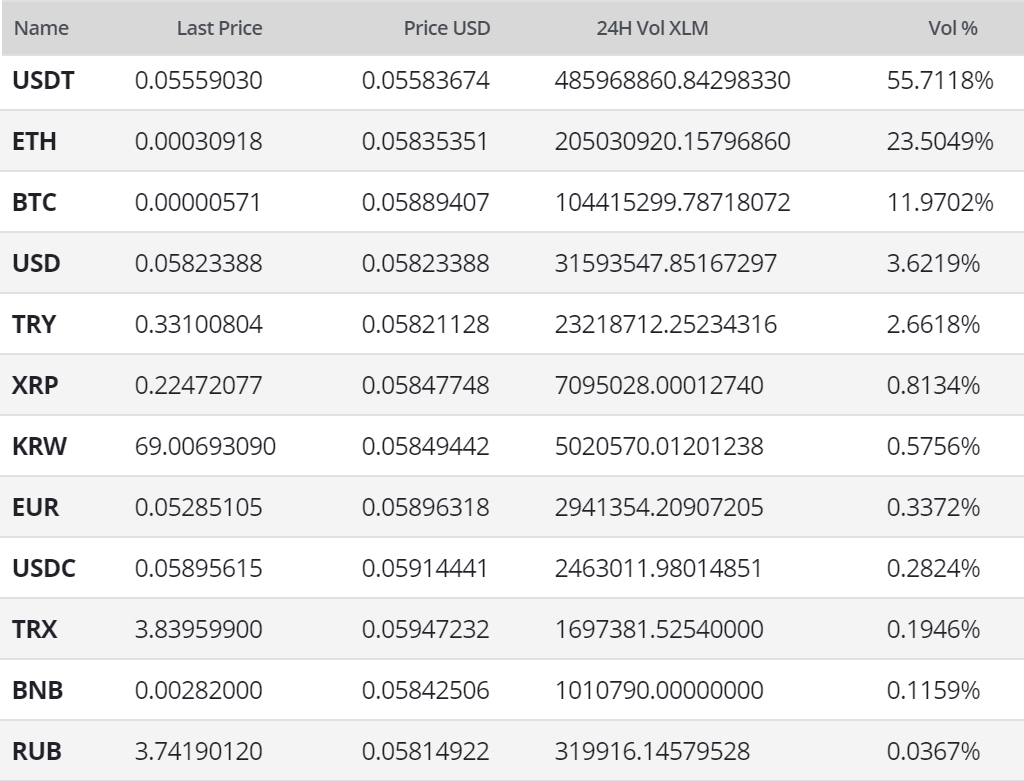
Worldwide Google Trends data for the term "Stellar" has remained low throughout most of 2018 and early 2019, with the exception of a small uptick in mid-May. There has also been a small rise recently, likely related to the press surrounding the Keybase airdrop announcement.
A slow rise in searches for "Stellar" preceded the bull run in Q4 2017, likely signaling a large swath of new market participants at that time. A 2015 study found a strong correlation between the google trends data and BTC price whereas a 2017 study concluded that when the U.S. Google "Bitcoin" searches increased dramatically, BTC price dropped.

Technical Analysis
Throughout late 2018, XLM followed the rest of the crypto market with a significant downward decline. Despite several bullish consolidation attempts since 2018, XLM has been unable to find bullish strength or develop a bullish trend. The strength of any potential trend reversal can be mapped using** **Exponential Moving Averages, Volume Profile of the Visible Range, and Ichimoku Cloud. Further background information on the technical indicators discussed below can be found here.
On the daily chart, the 50-day and 200-day Exponential Moving Averages (EMAs) have been bearishly crossed for 450 days. Price has mostly remained below the 200-day EMA since the Death Cross in June 2018. Over the next few months, if a bullish 50-day EMA and 200-day EMA cross occurs, bullish momentum will likely increase significantly. Volume resistance sits at US$0.1337 with a potential upside target of US$0.20-US$0.23. If the current local lows break, volume support sits around US$0.04. There are no volume or RSI divergences currently to suggest an end to the bearish trend.
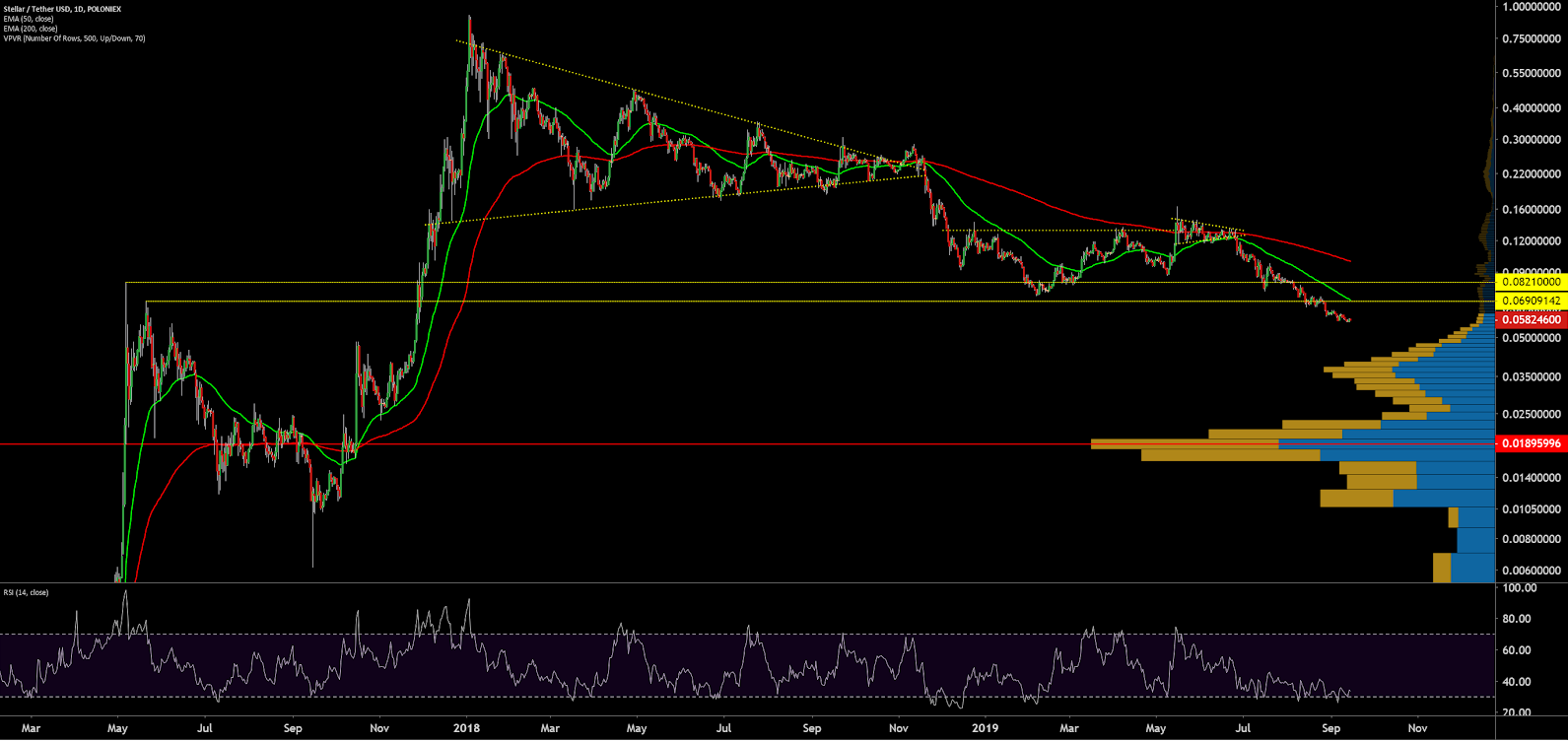
Turning to the Ichimoku Cloud, there are four key metrics; the current price in relation to the Cloud, the color of the Cloud (red for bearish, green for bullish), the Tenkan (T) and Kijun (K) cross, and the Lagging Span. Trades are typically opened when most of the signals flip from bearish to bullish, or vice versa.
Cloud metrics on the daily time frame with doubled settings (20/60/120/30), for more accurate signals, are bearish: price is below Cloud, the Cloud is bearish, the TK cross is bearish, and the Lagging Span is below Cloud and below price. The most prudent long entry will take place once price is above the Cloud with a bullish TK cross, otherwise, the trend will likely remain bearish.
However, there is currently a TK disequilibrium, which is suggestive of oversold conditions and an increasing likelihood of waning bearish momentum, as long as price does not make lower lows. When this occurs, a mean reversion attempt to the Kijun, which is currently US$0.077, is possible in the near term. Additionally, a flat Kumo near US$0.12 should also act as a magnet for price.
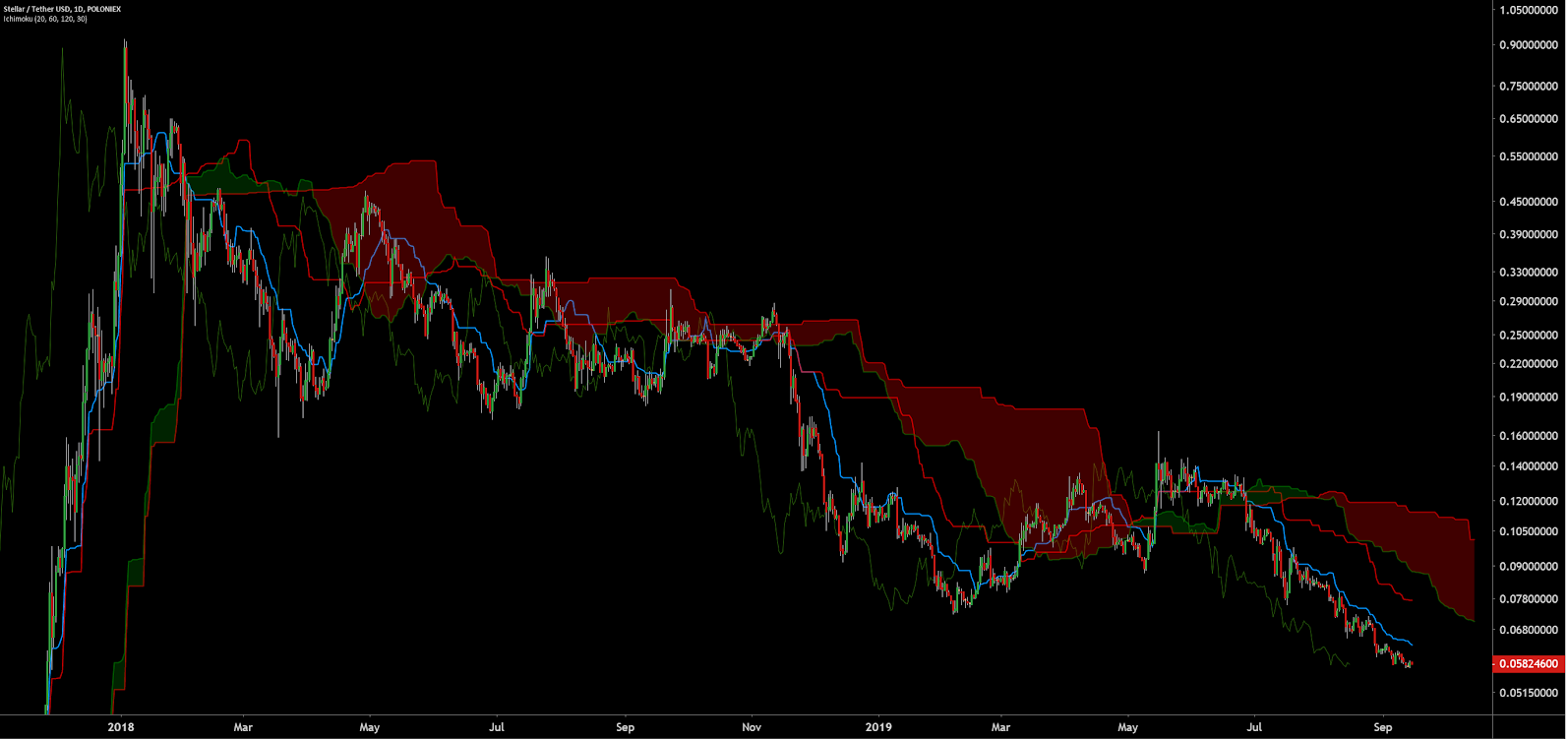
Lastly, the XLM/BTC pair shows a sustained bearish trend. Price has been below the Cloud since early December and the 50-day and 200-day EMAs have been bearishly crossed since December 22nd. A flat Kumo is forming near the 1,200 sat level, which may become a potential magnet for price if the current low holds. The 200-day EMA sits at 1,370 sats, with the current spot price 58% below this level, which suggests a growing potential for a mean reversion attempt back to the 200-day EMA. There is also an active RSI bullish divergence, suggesting weakening bearish momentum. On June 25th, RSI reached 10, the lowest level ever recorded for the pair.
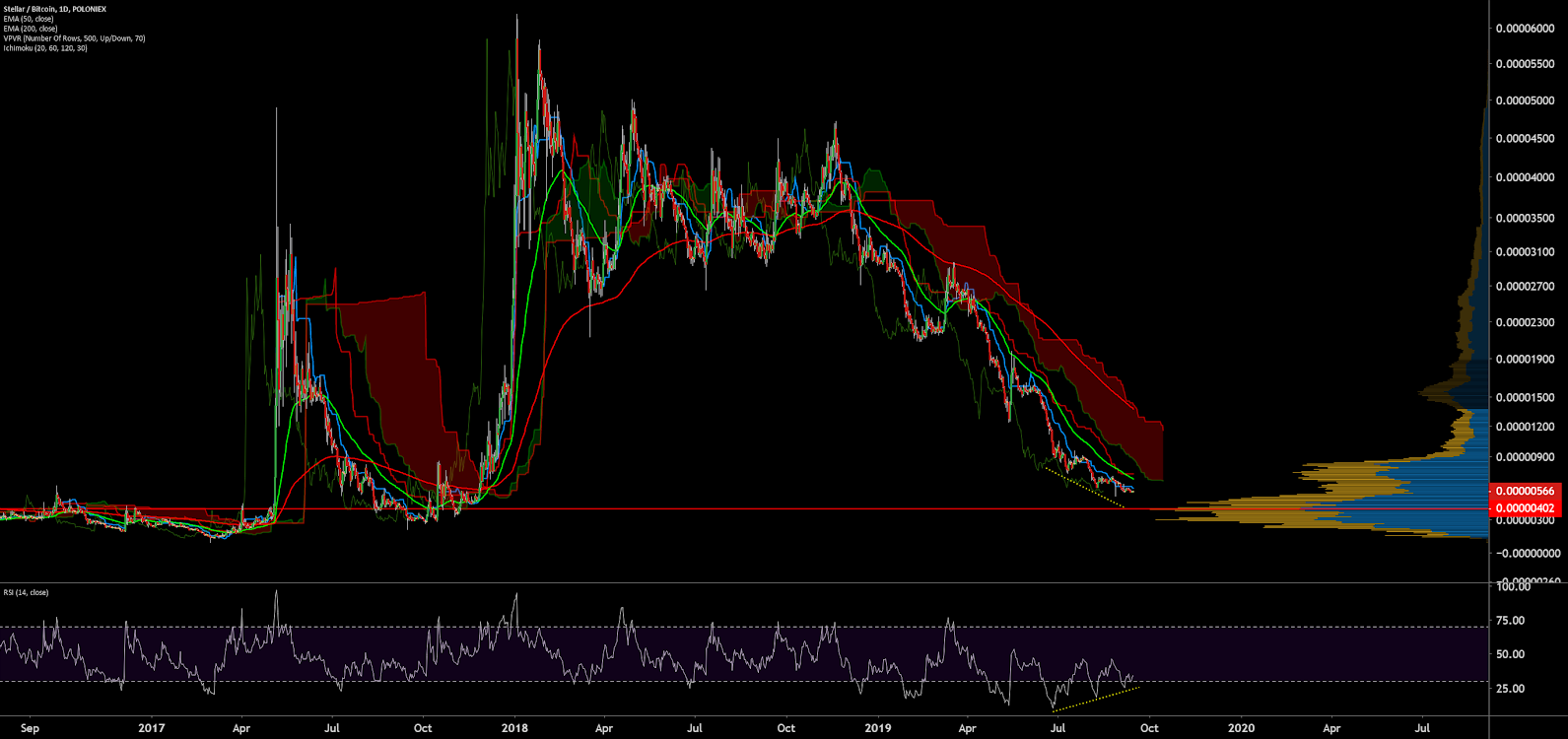
Conclusion
Despite Blockchain.com, Coinbase, and Keybase airdrops over the past year, active addresses continued to decline. Transactions and transaction values remain in their respective multi-month ranges. Based on the growing number of XLM partnerships, the network wants to directly compete with XRP in the payments and remittance realm, and ETH in the ICO and STO realm.
The low transactional cost on XLM is more attractive than its peers for ICOs, dApps, and general value transfer, but that competitive advantage will disappear if fees rise again. Development work on XLM remains highly active with a conference in Mexico City in November.
Technicals for the XLM/USD pair reveal bearish trend metrics with price below both the 200-day EMA and daily Cloud. If a Golden Cross does occur within the next few months, coupled with price action above the daily Cloud, sustained bullish momentum may break the current resistance at US$0.1337.
Technicals for the XLM/BTC pair remain bearish with price far below both the 200-day EMA and the daily Cloud. However, based on the distance from the 200-day EMA, as well as a growing bullish RSI divergence, mean reversion to 1,370 sats in the near term is likely as long as price does not make lower lows.
OhNoCrypto
via https://www.ohnocrypto.com
Josh Olszewicz, Khareem Sudlow
